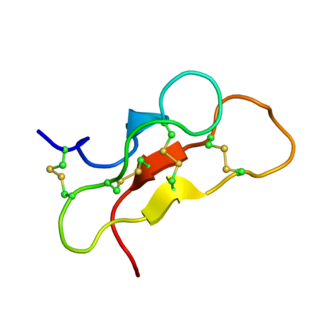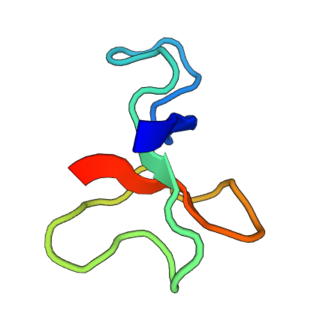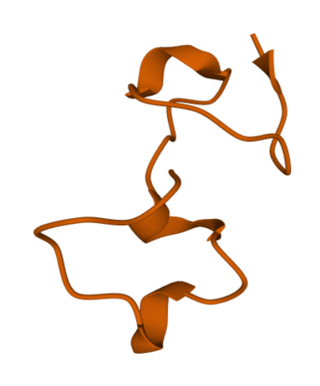Related Research Articles
Pompilidotoxins (PMTXs) are toxic substances that can only be found in the venom of several solitary wasps. This kind of wasp uses their venom to offensively capture prey and is relatively harmless to humans. This is in stark contrast to social insects that defend themselves and their colonies with their venom.
Birtoxin is a neurotoxin from the venom of the South African Spitting scorpion. By changing sodium channel activation, the toxin promotes spontaneous and repetitive firing much like pyrethroid insecticides do
AETX refers to a group of polypeptide neurotoxins isolated from the sea anemone Anemonia erythraea that target ion channels, altering their function. Four subtypes have been identified: AETX I, II, III and K, which vary in their structure and target.
BmKAEP is a neurotoxin from the venom of the Manchurian scorpion (Mesobuthus martensii). It is a β-toxin, which shift the activation voltage of sodium channels towards more negative potentials.

delta-Palutoxins (δ-palutoxins) consist of a homologous group of four insect-specific toxins from the venom of the spider Pireneitega luctuosa. They show a high toxicity against Spodoptera litura larvae by inhibiting sodium channels, leading to strong paralytic activity and eventually to the death of the insect.
Hainantoxins (HNTX) are neurotoxins from the venom of the Chinese bird spider Haplopelma hainanum. Hainantoxins specifically inhibit tetrodotoxin-sensitive Voltage-gated sodium channels, thereby causing blockage of neuromuscular transmission and paralysis. Currently, 13 different hainantoxins are known, but only HNTX-I, -II, -III, -IV and -V have been investigated in detail.
Huwentoxins (HWTX) are a group of neurotoxic peptides found in the venom of the Chinese bird spider Haplopelma schmidti. The species was formerly known as Haplopelma huwenum, Ornithoctonus huwena and Selenocosmia huwena. While structural similarity can be found among several of these toxins, HWTX as a group possess high functional diversity.
Halcurin is a polypeptide neurotoxin from the sea anemone Halcurias sp. Based on sequence homology to type 1 and type 2 sea anemone toxins it is thought to delay channel inactivation by binding to the extracellular site 3 on the voltage gated sodium channels in a membrane potential-dependent manner.
Calitoxin, also known as CLX, is a sea anemone neurotoxin produced by the sea anemone Calliactis parasitica. It targets crabs and octopuses, among other invertebrates. Two isoforms have been identified, both of which are formed from precursors stored in the stinging cells of the anemone. Once the toxin is activated and released, it causes paralysis by increasing neurotransmitter release at invertebrate neuromuscular junctions. Along with several other toxins derived from anemones, CLX is useful in ion channel research. Certain structural aspects of calitoxin are dissimilar from sea anemone toxins that also target the sodium ion channels. Other toxins resembling calitoxin function in completely different ways.
CgNa is a peptide toxin isolated from the sea anemone Condylactis gigantea. It causes an increased action potential duration by slowing down the inactivation of tetrodotoxin-sensitive sodium channels.
Kaliseptine (AsKS) is a neurotoxin which can be found in the snakelocks anemone Anemonia viridis. It belongs to a class of sea anemone neurotoxins that inhibits voltage-gated potassium channels.
LmαTX3 is an α-scorpion toxin from Lychas mucronatus. that inhibits fast inactivation of voltage gated sodium-channels (VGSCs).
SHTX is a toxin derived from the sea anemone Stichodactyla haddoni; there are four different subtypes, SHTX I, II, III and IV. SHTX I, II and III can paralyze crabs by acting on potassium channels, while SHTX IV works on sodium channels, and is lethal to crabs.
Kalicludine (AsKC) is a blocker of the voltage-dependent potassium channel Kv1.2 found in the snakeslocks anemone Anemonia viridis, which it uses to paralyse prey.

BcIII is a polypeptide sea anemone neurotoxin isolated from Bunodosoma caissarum. It targets the site 3 of voltage-gated sodium channels, thus mainly prolonging the inactivation time course of the channel.
ATX-II, also known as neurotoxin 2, Av2, Anemonia viridis toxin 2 or δ-AITX-Avd1c, is a neurotoxin derived from the venom of the sea anemone Anemonia sulcata. ATX-II slows down the inactivation of different voltage-gated sodium channels, including Nav1.1 and Nav1.2, thus prolonging action potentials.
LmαTX5 is an α-scorpion toxin which inhibits the fast inactivation of voltage-gated sodium channels. It has been identified through transcriptome analysis of the venom gland of Lychas mucronatus, also known as the Chinese swimming scorpion – a scorpion species which is widely distributed in Southeast Asia.

BcsTx3, also known as Kappa-actitoxin-Bsc4a, is a neurotoxin that blocks voltage-gated potassium channel (Kv1/KCNA). It is purified from the venom of Bunodosoma caissarum.

Delta hexatoxin Hv1 is a neurotoxic component found in the venom of the Australian funnel web spider.
Tb1 is a neurotoxin that is naturally found in the venom of the Brazilian scorpion Tityus bahiensis. Presumably by acting on voltage-gated sodium channels, it triggers excessive glutamate release, which can lead to both behavioral and electrographic epileptiform alterations, as well as neuronal injury.
References
- 1 2 3 4 5 6 Cunha, RB; Santana, ANC; Amaral, PC; Carvalho, MDF; Carvalho, DMF; Cavalheiro, EA; Maigret, B; Ricart, CAO; Cardi, BA; Sousa, MV; Calvalho, KM (2005). "Primary structure, behavioral and electroencephalographic effects of an epileptogenic peptide from the sea anemone Bunodosoma cangicum". Toxicon. 45 (2): 207–217. doi:10.1016/j.toxicon.2004.10.011. PMID 15626370.
- ↑ Dias, TBJ; Moura, E; Guedes, S; Damasceno, LC (2007). "Predation of the sea anemone Bunodosoma cangicum Corrêa, 1964 (Cnidaria, Anthozoa, Actiniidae) on a swimming crab Callinectes sp. Stimpson, 1860 (Decapoda, Brachyura, Portunidae)" (PDF). Panamajas. 2 (3): 2.
- ↑ Treptow, WL; Sousa, MV; Carvalho, KMC; Maigret, B (2003). "The structure of a new anemone toxin: a molecular modeling study of cangitoxin". J. Mol. Struct. 624 (1–3): 87–95. doi:10.1016/S0166-1280(02)00713-3.
- 1 2 3 Zaharenko, AJ; Ferreira Jr., WA; de Oliveira, JS; Konno, K; Richardson, M; Schiavon, E; Wanke, E; de Freitas, JC (2008). "Revisiting cangitoxin, a sea anemone peptide: purification and characterization of cangitoxins II and III from the venom of Bunodosoma cangicum". Toxicon. 51 (7): 1303–1307. doi:10.1016/j.toxicon.2008.01.011. PMID 18342901.
- ↑ Oliveira, JS; Redaelli, E; Zaharenko, AJ; Cassulini, RR; Konno, K; Pimenta, DC; Freitas, JC; Clare, JJ; Wanke, E (2004). "Binding specificity of sea anemone toxins to Nav 1.1-1.6 sodium channels: unexpected contributions from differences in the IV/S3-S4 outer loop" (PDF). J Biol Chem. 279 (32): 33323–33335. doi: 10.1074/jbc.M404344200 . PMID 15169781.
- 1 2 3 Catterall, WA; Cestele, S; Yarov-Yarovoy, V; Yu, FH; Konoki, K; Scheuer, T (2007). "Voltage-gated ion channels and gating modifier toxins" (PDF). Toxicon. 49 (2): 124–141. doi:10.1016/j.toxicon.2006.09.022. PMID 17239913.